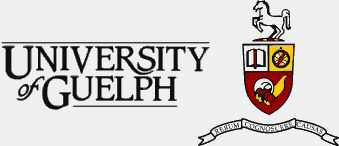University of Guelph
|
|
Motto: Rerum cognoscere causas (Latin: To learn the meaning of reality) | |
| Chancellor | Lincoln Alexander |
| President | Alastair Summerlee |
| School type | Public |
| Religious affiliation | None |
| Founded | 1964 |
| Location | Guelph, Ontario, Canada |
| Enrollment | 15,708 undergraduate 1,894 graduate Full & Part-time (2003) |
| Campus surroundings | Urban, suburban |
| Campus size | 4.1 km² (1017 acres) |
| Sports teams | Gryphons |
| Mascot | "Gryph" |
| Colours | Red, gold, black |
Established in 1964, the University of Guelph is a medium-sized university located in Guelph, Ontario, Canada. While U of G offers degrees in many different disciplines, the University is best-known for its focus on life sciences, based in part a long-standing history in Agriculture and Veterinary Medicine.
The University of Guelph is frequently ranked by Maclean's magazine as the top comprehensive university in Canada (defined as institutions with significant research activity and a range of programs at the undergraduate and graduate levels, including professional degrees). It held this ranking in 1999, 2002, and 2003, with its reputation, innovative research-intensive programs, and lively campus life cited as particular strengths.
The university is also home to the Ontario Veterinary College, Ontario's only veterinary school.
The university is represented in Canadian Interuniversity Sport by the Guelph Gryphons.
| Contents |
Campus
The main university campus spans 1,017 acres (4.1 km²), including a 408 acre (1.7 km²) arboretum and a 30 acre (0.1 km²) research park. It is home to 16,219 full-time students (graduate and undergraduate) and 2,740 faculty and staff (2003).
The campus, which mixes old-fashioned brick buildings with more contemporary stone structures, is generally regarded as scenic. It is well-populated with trees, including those which line the main walkways, many of which are paved with red brick. The campus includes an arboretum with an impressive collection of trees.
In Branion Plaza, at the campus' centre, is the University of Guelph cannon, sometimes called "Old Jeremiah"; originally a British naval gun, its provenance is not well-established. The cannon enjoyed relative tranquility until the 1950s when some entrepreneuring student came up with the idea of painting a message on the highly-visible landmark. The act of "painting the cannon" has since become a campus tradition with students, residences, sports teams, clubs and others braving the early morning hours to paint messages on the cannon, most often about upcoming events but also including birthday announcements and public insults. The etiquette governing "Painting the cannon" is unofficial but well-understood: 1) be finished by the time the first students arrive for classes in the morning, and 2) avoid profanity or coarse language. It is well-accepted practice to "guard" the cannon until sunrise so as to avoid another person or group painting over one's message.
Another highly-visible landmark is Johnston Hall, constructed in 1931. The Johnston Clocktower overlooks Winegard Walk and is visible from much of the campus. The building also overlooks Johnston Green, a popular location for recreational sporting activities and outdoor concerts.
Student Media
The University of Guelph has two campus newspapers, The Ontarion and The Peak. It also has a radio station, CFRU-FM.
Administrative structure
The University of Guelph is the amalgam of six Colleges:
- College of Social and Applied Human Sciences
- College of Arts
- College of Biological Science
- College of Physical and Engineering Science
- Ontario Agricultural College
- Ontario Veterinary College
In addition, the university has partnered with Humber College to create the University of Guelph-Humber in Toronto.
Presidents
- Mordechai Rozanski (1993-2003)
- Alastair Summerlee (2003-)
History
The Ontario Agricultural College (OAC) began in 1873 as an associate agricultural college of the University of Toronto. Its first building was Moreton Lodge, located where Johnston Hall now stands, which included classrooms, residences, a library, and a dining room. (Several buildings constructed during this time period are still a part of campus life today, including President's Residence, Raithby House, and Day Hall.)
The Macdonald Institute was established in 1903 to house women's home economics programs at the college. The growth spurt from 1900 to 1906 also saw the construction of MacDonald Hall, Massey Hall, and the Bullring (currently known as 'The Ring').
Several important buildings were opened in 1922, including the Ontario Veterinary College main building, Mills Hall (formerly a boys residence, converted to co-ed in 2000), and Food Science. Johnston Hall was constructed in 1931, taking the place of the torn-down Moreton Lodge. Johnston would house the OAC Administration from that year forth.
In 1964, the Ontario Agricultural College, the Macdonald Institute, and the Ontario Veterinary College amalgamated and were granted University status, giving life to the University of Guelph as it is now known.
Shortly after, during the period of 1967 to 1975, massive construction took place, giving rise to many new and expansive buildings such as the McLaughlin Library, the MacKinnon Building, the University Centre, and South Residence.
New construction has been taking place since 2001 as a result of the anticipated rise in enrollment due to the Ontario double cohort and population increases. New buildings already constructed include the Gryphon Dome, the East Village Residences, and Rozanski Hall. A state-of-the-art science complex is currently being constructed.
College Royal
An annual feature of the university is its open house, known as the College Royal (http://www.collegeroyal.uoguelph.ca/). For a weekend each March, every part of the campus and its programs is shown off to the public, from the barns of the Agricultural College to the sugar bush in the arboretum. It is highly popular to visitors of all ages, especially families with children who take advantage of the March break (the usual Ontario school break) date to have an outing.
External link
- University of Guelph (http://www.uoguelph.ca)



